Different Types Of Dandruff And How To Stop Them
Just like different hair and skin, even your dandruff has various types.
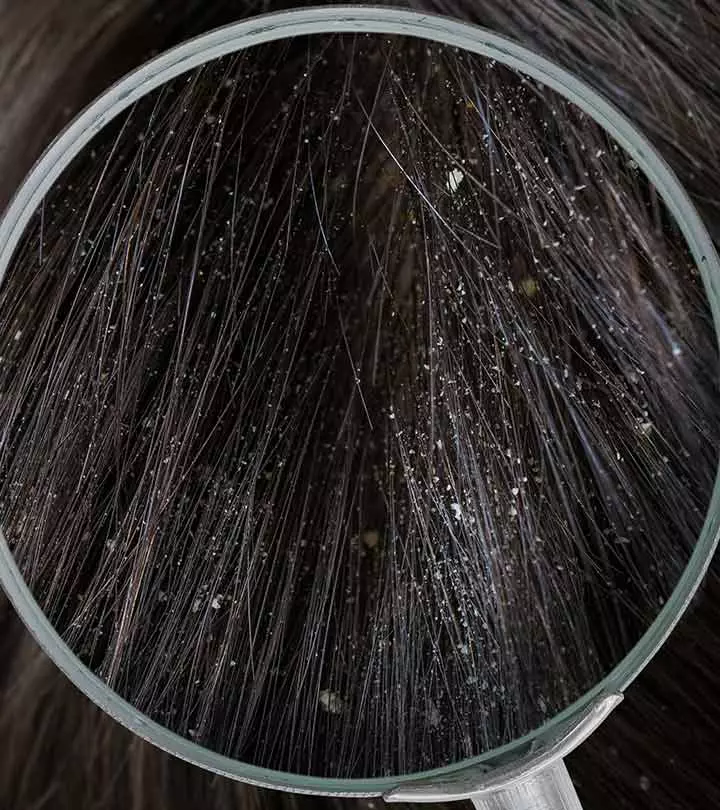
Image: istock
Dandruff is mainly characterized by white flakes in hair and is accompanied by symptoms like inflammation and an itchy scalp (1). Even though it is an annoying hair problem, it can be treated. But how do you find out what type of dandruff you have?
A variety of factors can cause dandruff. It can manifest itself in various ways, which must be understood before starting treatment. This article has explained the different types of dandruff and how to treat them. Keep reading.
In This Article
Different Types Of Dandruff
1. Dry Skin-Related Dandruff
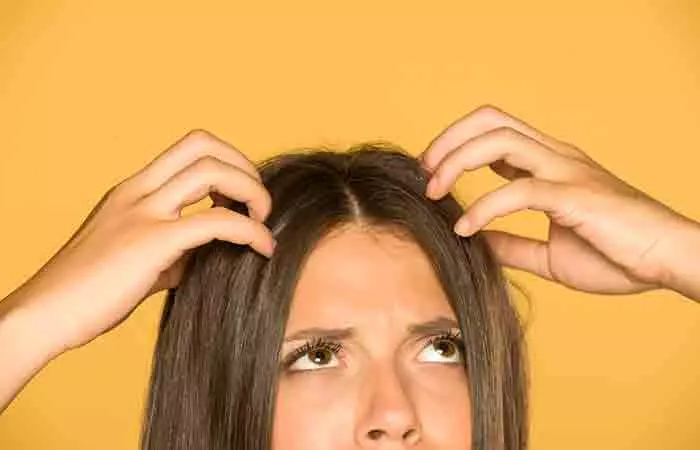
Dandruff often develops in people who generally have a dry scalp (2). Dry skin on the scalp can be caused due to extreme cold weather (as in winter months) or irregular hair shampooing.
People with curly hair may have a scalp drier than those with other hair types (3). Using sulfate shampoos that create a lot of foam can also cause and aggravate dry skin-related dandruff.
Symptoms: A feeling of tightness on your scalp and small, round, white dry flakes in hair.
However, understanding the difference between dandruff vs. dry scalp is key to effective treatment.
2. Oily Scalp-Related Dandruff
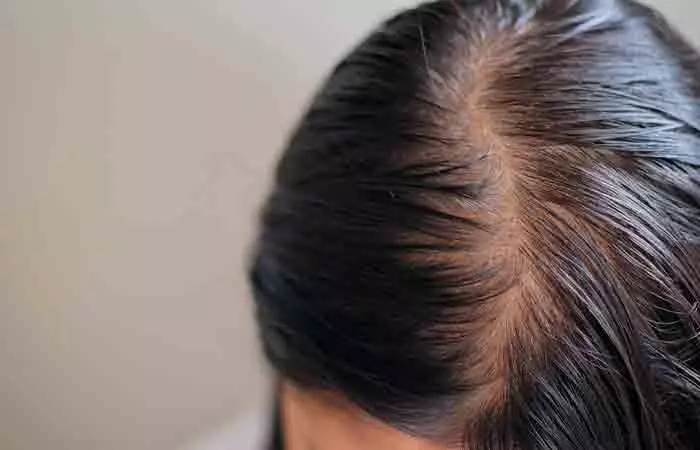
This condition is characterized by an oily scalp. Sometimes, your body can start producing excess sebum (the natural oil produced by sebaceous glands) (1). Sebum, in normal quantities, can help moisturize your hair and skin and keep them from drying. It may also help delay certain signs of aging.
However, overproduction of this sebum, which could occur due to puberty, pregnancy, stress, or irregular shampooing, can cause problems. When the excess sebum mixes with dirt and dead skin cells, it forms dandruff.
Symptoms: Yellow patches on the scalp, yellowish large dandruff flakes on the scalp, itching, and greasy hair.
3. Fungal Dandruff
Fungal dandruff is a result of a scalp infection caused by the Malassezia globosa fungus.
This fungal infection spreads quite rapidly when your scalp is excessively oily or has a pH imbalance 1. Malassezia produces oleic acid that increases the turnover of skin cells. This causes dandruff.
Symptoms: White or yellowish dandruff flakes and itchiness.
4. Dandruff Caused By Product Buildup
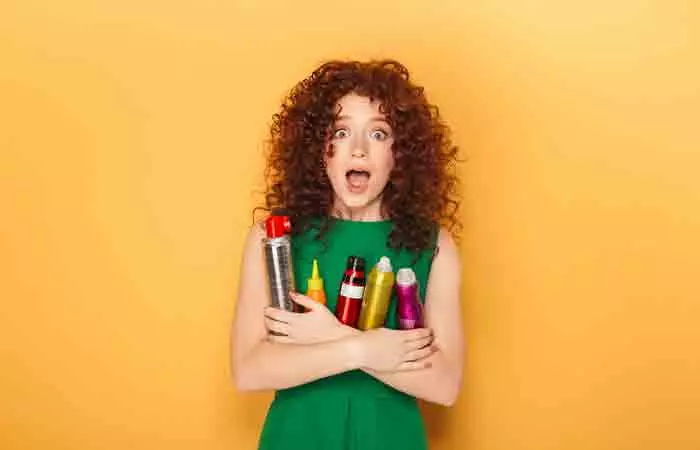
Using too many styling products (including leave-in conditioners, gels, serums, pomades, mousses or hair sprays) can cause them to accumulate on your scalp. This build-up can combine with dirt and dead skin cells to form dandruff. It could also lead to hair loss.
Symptoms: Big whitish or yellowish large flakes on the scalp, irritation, and hair fall.
5. Dandruff Caused By Seborrheic Dermatitis
Seborrheic dermatitis or pityriasis steatoides is a chronic inflammatory skin condition that can develop on parts of your body with a higher concentration of sebaceous glands
. This includes your scalp, neck, areas behind your ears, face, and eyebrows.
Studies show that this scalp dermatitis is usually caused by an inflammatory reaction to yeast that is naturally found on your skin’s surface. Stress and hormonal changes could trigger seborrheic dermatitis (4).
Symptoms: Huge, white or yellowish dandruff flakes, scaly patches, greasiness, redness, and irritation.
 Did You Know?
Did You Know?Dandruff could be an all-consuming part of someone’s life. One may even feel embarrassed in a company. But it doesn’t have to be so. Dandruff can easily be treated with the help of a few products and other natural methods.
6. Dandruff Caused By Psoriasis
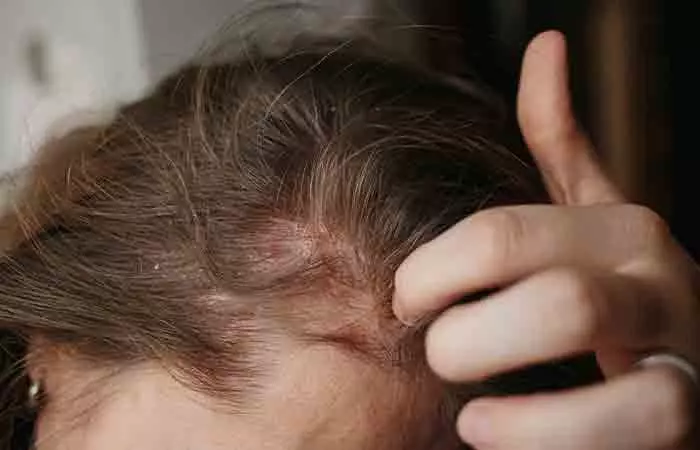
Psoriasis is a chronic skin condition in which the immune system starts attacking healthy skin tissues. This leads to the rapid production of new skin cells before the old dead skin flakes off. The result is the formation of thick silver-colored scaly patches on your scalp, neck, knees, and back (4).
Psoriasis on scalps is a common condition. According to a cross-sectional study conducted on 4016 adults with psoriasis, the most frequently affected area was the scalp (43%). It was followed by the face (29.9%), nails (24.5%), soles (15.6%), genitals (14.1%), and palms (13.7%), respectively.
Symptoms: Silver-colored scaly patches, thick white big flakes on the scalp, redness, and mild itching.
Dandruff could be an all-consuming part of someone’s life. One may even feel embarrassed in a company. But it doesn’t have to be so. Jessica Shults, a hairstylist, says, “Dandruff is not contagious and can not be spread from one to another.” It can easily be treated with the help of a few products and other natural methods.
Key Takeaways
- Dandruff can occur due to dry or oily scalp, and scalp infection.
- Using anti-dandruff shampoos and avoiding chemical hair treatments may help in treating dandruff.
- You can use natural remedies such as olive oil, and tea tree oil to manage dandruff.
- Include some essential nutrients like B vitamins and zinc in your diet.
Tips To Prevent Dandruff
With Hair Products
- There are several over-the-counter anti-dandruff shampoos that you can use to treat and prevent dandruff (3). Ensure you pick one that suits your sensitive scalp and contains any of the following ingredients:
- Ketoconazole
- Salicylic acid
- Selenium sulfide
- Coal tar
- Zinc pyrithione
- Cyclopiroxolamine
- Luliconazole
- Some vital nutrients that you need to include in your diet to prevent dandruff are zinc, B vitamins, and fats (5).
- Avoid going in for chemical hair treatments like perms, hair colors, and relaxing (3).
- Brush and wash your hair with a sulfate-free shampoo regularly.
- Abstain from using too many hair styling products (3).
- Wash your scalp with lukewarm or cold water. Avoid hot water.
Avia Sky, a blogger, recounts her long-standing struggle with severe dandruff since middle school, causing embarrassment and discomfort. After unintentionally creating a hair growth treatment that includes a mixture of oils, massaging, and washing, she noticed that the dandruff disappeared significantly after just three treatment applications. She notes, “Three treatments later and my dandruff was 95% gone. I was shocked! My hair had never felt cleaner or clearer. I run my hand through my hair and waited for the snow flakes…but nothing.. like seriously nothing fall from my head! (i)”.
 Quick Tip
Quick TipWith Natural Methods
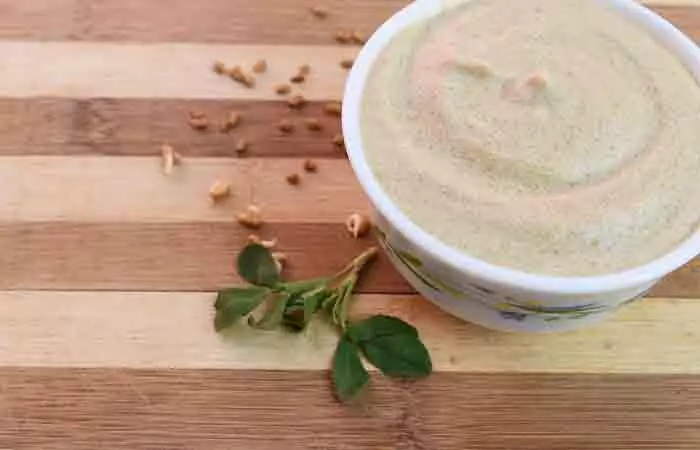
Note: These natural methods are based on anecdotal reports.
- Fenugreek Seeds: Soak 2 tablespoons of fenugreek seeds overnight and grind them into a paste. Apply this paste all over your scalp and leave it on for 30 minutes. Wash it off with soapnut (reetha) and water. Using fenugreek seeds for dandruff can help soothe the scalp.
- Olive Oil: Massage your scalp with olive oil for 10 minutes and leave it on overnight. Wash it off with water and a mild shampoo the next morning.
- Apple Cider Vinegar: Mix 2 cups of apple cider vinegar in 2 cups of water and pour it all over your scalp after shampooing it. Massage it in for a few minutes before washing it with water.
- Baking Soda: Using baking powder for dandruff is a natural and cost-effective way to treat dandruff. Mix 3 tablespoons of baking soda and 3 tablespoons of lemon juice into a bowl of apple cider vinegar. Apply this paste all over your scalp and leave it on for 10 minutes. Wash it off with water.
- Tea Tree Oil: Add a few drops of tea tree oil to coconut oil and massage it onto your scalp and hair. You can leave it on overnight before washing it off with herbal shampoo.
- Coconut Oil: Massage a small amount of warm, extra-virgin coconut oil onto your scalp and leave it on for 30 minutes. Shampoo thoroughly and rinse with lukewarm water.
- Aloe Vera: Apply fresh aloe vera pulp to your scalp, and massage gently. Leave it on for 15-20 minutes, then rinse with cold water.
- Eucalyptus Oil: Add a few drops of eucalyptus oil to your shampoo and wash your hair with it. You can also warm up 2 tablespoons of coconut oil, add a few drops of eucalyptus oil, and massage it into your scalp. Leave it overnight and wash it off with a mild shampoo the following day.
- Lemongrass Oil: Add a few drops of lemongrass oil to 2-3 tablespoons of jojoba oil. Apply it to your scalp and leave it on overnight. Wash it off the next day. You can also add a few drops of the oil to your shampoo and rinse your hair with it.
Natural methods, like using probiotics, have shown potential benefits in the management of dandruff as well as promoting healthy hair. A study showed dandruff can be reduced when adding natural probiotics to hair care remedies (6).
If you are considering oil for dandruff treatment, it is crucial to have the right hair oil for dandruff that can nourish and hydrate your hair and help you achieve a flake-free scalp.
While these remedies are known to work well, if they fail to curb dandruff or you experience recurring symptoms, do not hesitate to seek evaluation by a dermatologist. They can provide you with the right cause of and treatment for the issue. Continue reading to know what to watch for and when professional help is really required.
When To Consult A Doctor
If you have dandruff or an extreme level of irritation of the scalp even after trying home remedies and over-the-counter products, you may be wondering if it’s time to consult a doctor. Here are some obvious signs that call for a professional evaluation:
- If symptoms last over a period of weeks or if the itching or irritation continues despite trying your best to treat it with over-the-counter medications, then it is time to see a doctor.
- If you struggle with extreme itchiness that hinders your daily chores or sleep, then you should seek attention from a medical professional.
- If you notice red patches and scaly skin, then there are chances you may be dealing with a skin condition, like psoriasis or eczema. Seek specialized treatment immediately.
- It’s very crucial to see a dermatologist if you have started experiencing excessive hair loss or balding patches.
- If you experience a sudden change or swelling, oozing, or crusting of the scalp, it must be addressed instantly. This may imply an infection or another dermatological condition.
These symptoms will help you tackle your scalp problems early and effectively in order to regain your hair and scalp’s health.
Infographic: 6 Most Common Types Of Dandruff
Tackling dandruff begins with knowing what type of dandruff is plaguing your scalp, because that’s where the cause lies. Check out the following infographic for a brief and handy guide to all the common types of dandruff and what symptoms to look for when identifying them.

Illustration: StyleCraze Design Team
Dandruff is a persistent condition that affects millions of people worldwide. Several factors such as dryness, inflammation, or oiliness can cause dandruff. It can show itself in various ways, like the flaky scalp, itchy scalp, and scaly patches, which must be recognized before the treatment begins. To get rid of dandruff, you do not need to spend a lot of money. This issue can be avoided by making easy modifications to your hair care practice and following some home treatments. These home remedies for dandruff are simple solutions that help you achieve a healthier scalp. However, if the itching continues and you discover red, scaly patches on your scalp, you must see a dermatologist immediately.
Frequently Asked Questions
Should you scratch dandruff?
Shults says, “You should not scratch dandruff, as it can irritate the scalp, and in worse case scenarios, it may result in hair loss and/ or infections. If you need to relieve the itch, try using a cortisone cream or a cold wet washcloth.”
Is combing out dandruff good?
According to Shults, “Gently combing out dandruff can be good to an extent as it will stimulate the blood flow throughout the scalp and loosens dandruff flakes much like an exfoliant. Combing helps with the symptoms, but does not cure the underlying condition, which is an overgrowth of a naturally occurring fungus.”
Does picking at dandruff make it worse?
Shults says, “Picking at dandruff can make it worse if you don’t fix the underlying condition, which is an overactive fungus growth, and the way to cure it is with certain shampoos.”
Does washing your hair with hot water cause dandruff?
Washing your hair with hot water may cause dandruff as it dries out your scalp.
Can washing your hair every day cause dandruff?
If your scalp is too dry, washing your hair every day can cause dandruff. Moderation is key. You may shampoo your hair once every two or three days. You can wash your hair with plain water every day. For persistent cases, knowing how to treat chronic dandruff is essential for long-term relief.
How many times should I use dandruff shampoo in a week?
The frequency can vary from person to person. Check what suits you. Follow the directions given on the bottle.
How do I know if it’s lice or dandruff?
Dandruff just appears as white or yellow flakes on your scalp. Lice, on the other hand, can give rise to nits (tiny white specks on your hair shafts), nymphs (small, tan-colored lice), and adult louse.
Does dandruff spread from one person to another?
No, dandruff is not contagious and cannot be passed from one person to another.
What can dandruff be mistaken for?
Dandruff is often mistaken for seborrheic dermatitis, psoriasis, contact dermatitis, atopic dermatitis, allergic dermatitis, and tinea capitis. They appear very similar because both produce skin flakes in and beneath the hair. Some might mistake the cradle cap on the baby’s scalp for dandruff.
How do I know if it’s dandruff or psoriasis?
Dandruff is a skin condition characterized by crusty, whitish flakes on the scalp. An itchy scalp is the primary symptom of dandruff. Dry skin can cause dandruff and an itchy scalp.
An even worse and more severe skin condition is psoriasis. It causes patchy, red, dead skin that is quite noticeable on the scalp. It may even affect the neck, knees, and elbows. It causes the skin to become dry first and then crack, which eventually may bleed and cause more itching, discomfort, and burning.
Illustration: Different Types Of Dandruff And How To Stop Them
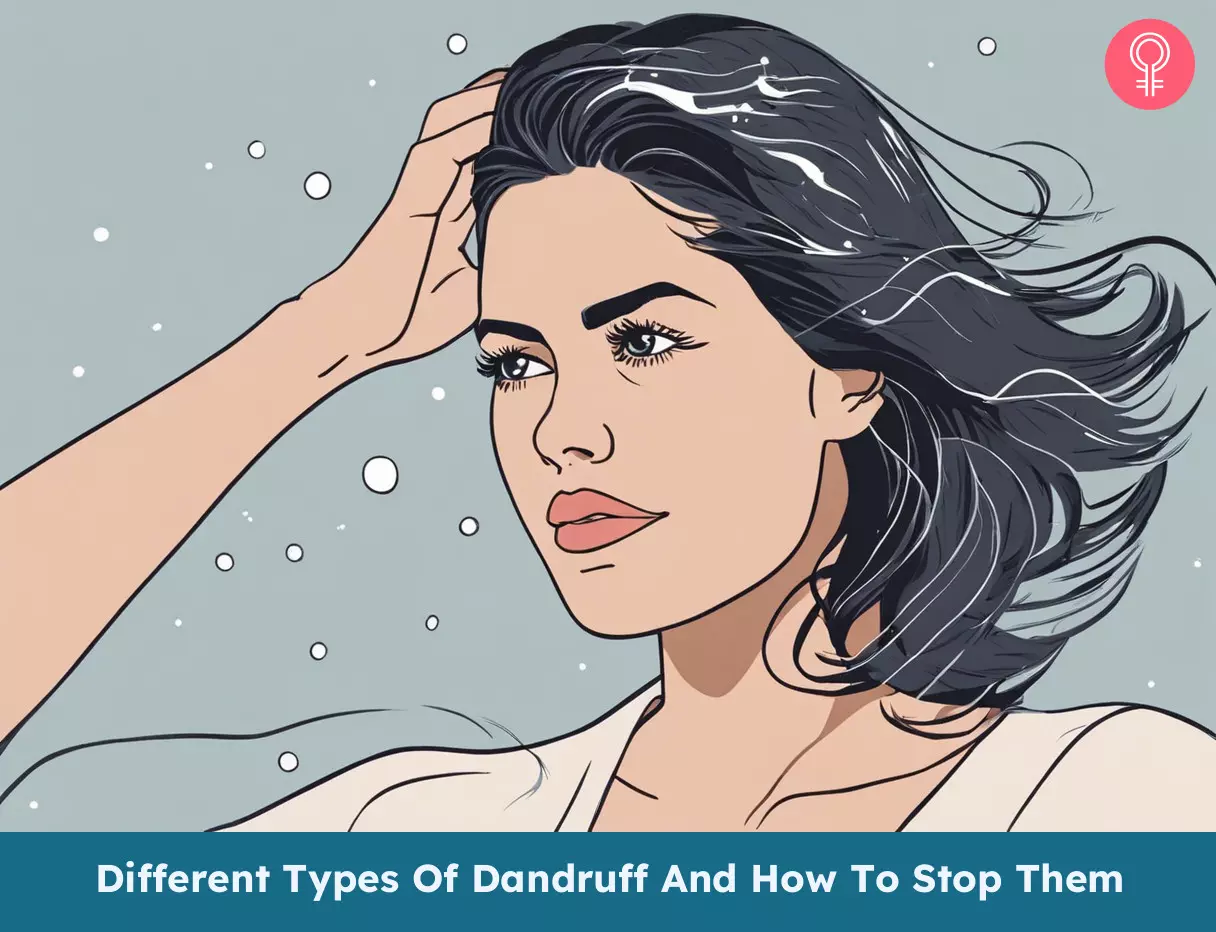
Image: Stable Diffusion/StyleCraze Design Team
Are you struggling with an itchy scalp? Not sure if it’s dandruff or a dry scalp? Learn what you need to know by clicking on this informative video.
Personal Experience: Source
StyleCraze's articles are interwoven with authentic personal narratives that provide depth and resonance to our content. Below are the sources of the personal accounts referenced in this article.
i. How I Got Rid of My Dandruff in 2 Weeks By Accidenthttps://aviasky.medium.com/how-i-got-rid-of-my-dandruff-in-2-weeks-by-accident-e98010e482cb
References
Articles on StyleCraze are backed by verified information from peer-reviewed and academic research papers, reputed organizations, research institutions, and medical associations to ensure accuracy and relevance. Read our editorial policy to learn more.
- Dandruff: The Most Commercially Exploited Skin Disease
https://www.ncbi.nlm.nih.gov/pmc/articles/PMC2887514/ - A New Postulate on Two Stages of Dandruff: A Clinical Perspective
https://www.ncbi.nlm.nih.gov/pmc/articles/PMC3129121/ - Hair Cosmetics: An Overview
https://www.ncbi.nlm.nih.gov/pmc/articles/PMC4387693/ - Seborrheic Dermatitis And Dandruff: A Comprehensive Study
https://www.ncbi.nlm.nih.gov/pmc/articles/PMC4852869/ - The Role Of Vitamins And Minerals In Hairloss: A Review
https://www.ncbi.nlm.nih.gov/pmc/articles/PMC6380979/ - Efficacy of probiotics in hair growth and dandruff control: A systematic review and meta-analysis
https://pubmed.ncbi.nlm.nih.gov/38698995/
Read full bio of Dr. Zeel Gandhi
- Jessica Shults is an expert hair stylist with over 20 years of experience in hairstyling and coloring. She completed the cosmetology program at New York State BOCES and specializes in balayage and best-in-class gray blending techniques. She has also launched Twisted Scissors Salon, a full-service hair salon.
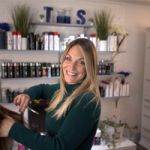 Jessica Shults is an expert hair stylist with over 20 years of experience in hairstyling and coloring. She completed the cosmetology program at New York State BOCES and specializes in balayage and best-in-class gray blending techniques. She has also launched Twisted Scissors Salon, a full-service hair salon.
Jessica Shults is an expert hair stylist with over 20 years of experience in hairstyling and coloring. She completed the cosmetology program at New York State BOCES and specializes in balayage and best-in-class gray blending techniques. She has also launched Twisted Scissors Salon, a full-service hair salon.
Read full bio of Arshiya Syeda
Read full bio of Ramona Sinha
Read full bio of Swathi E






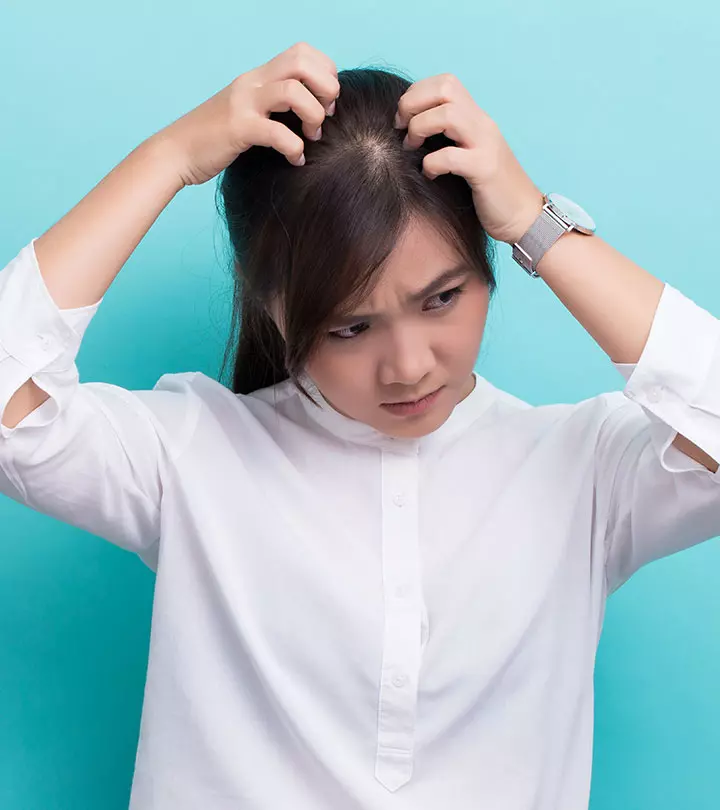
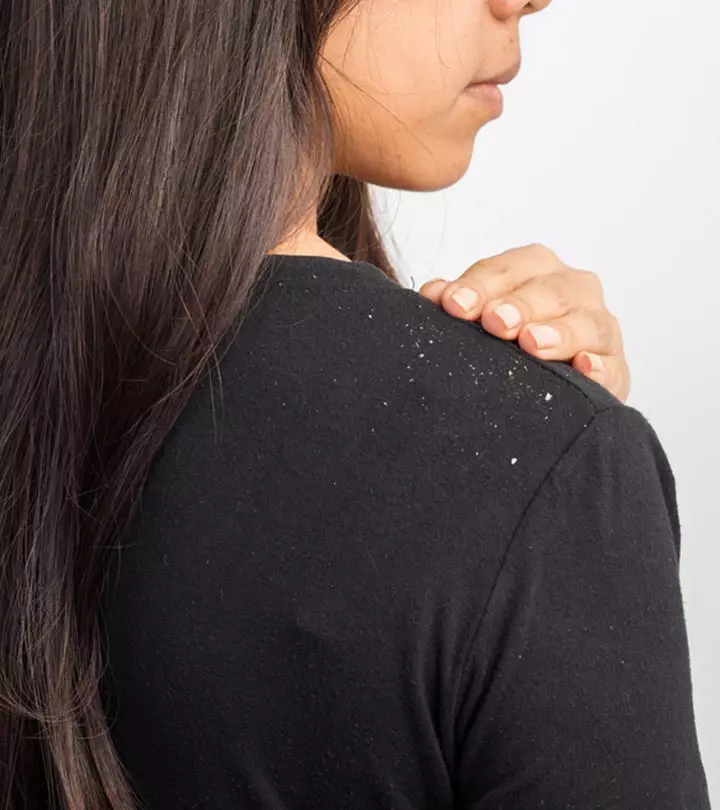

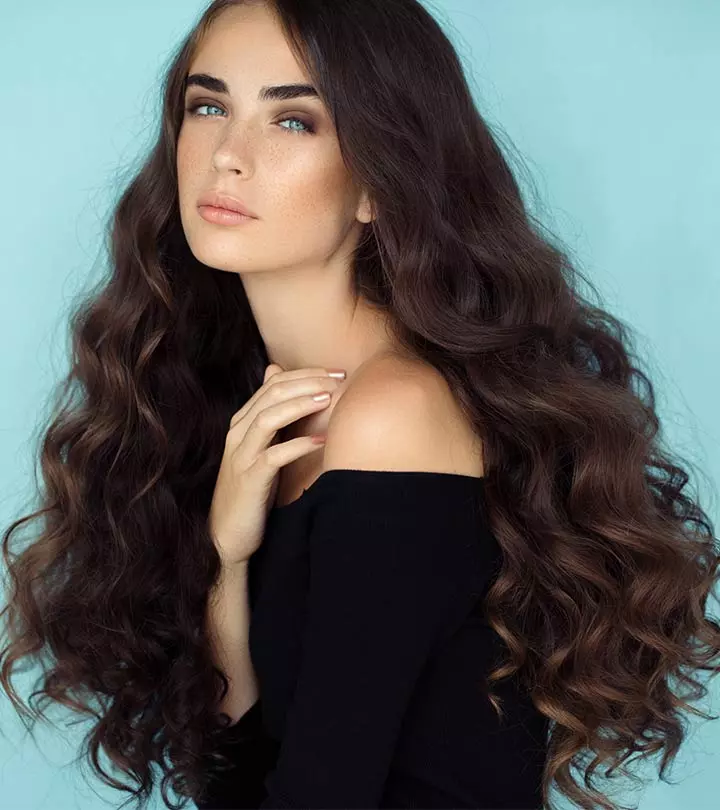
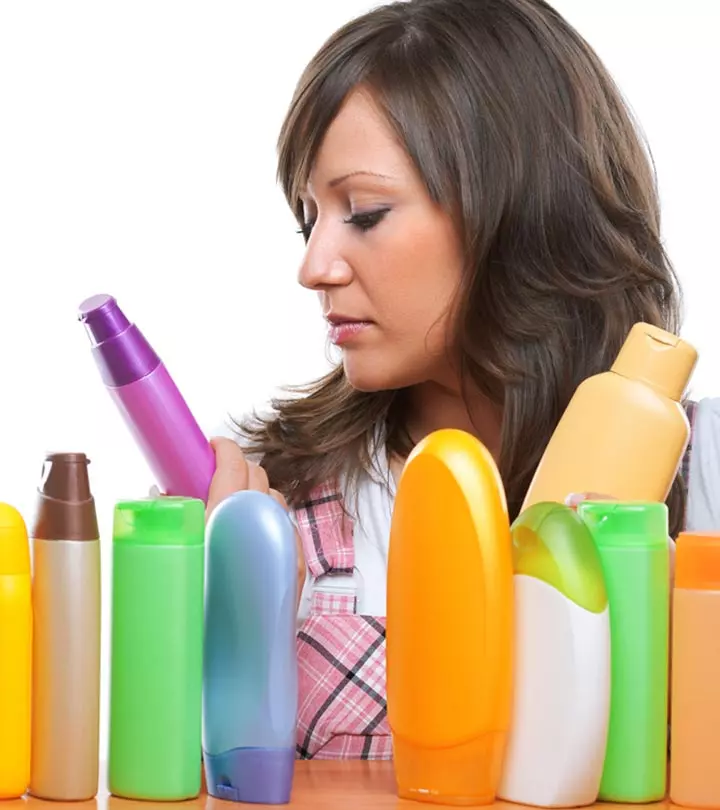

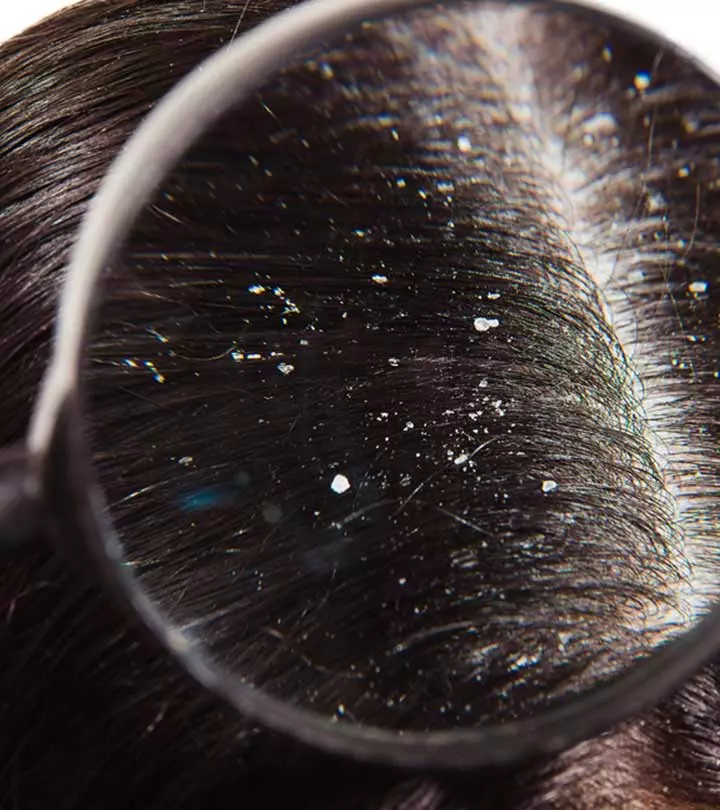
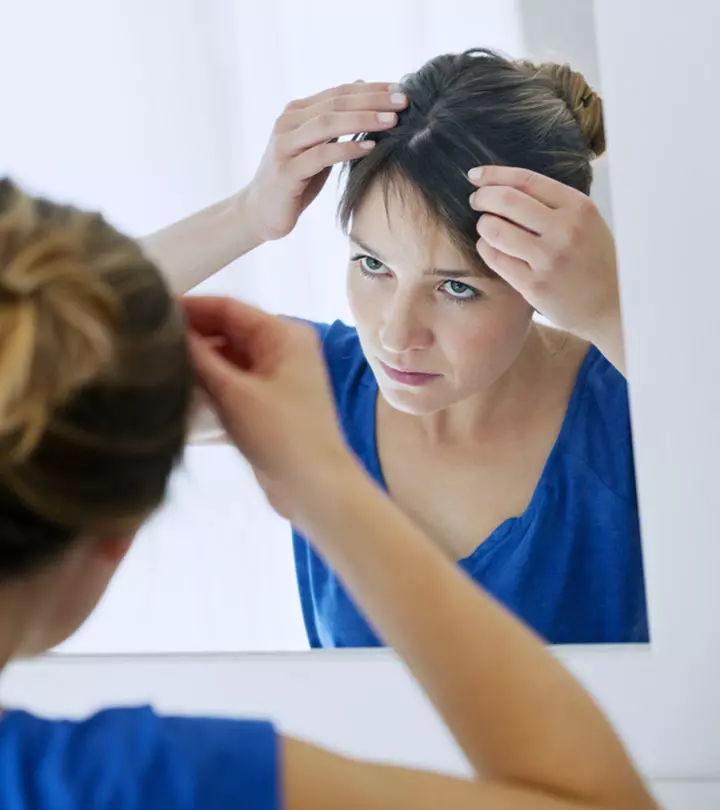
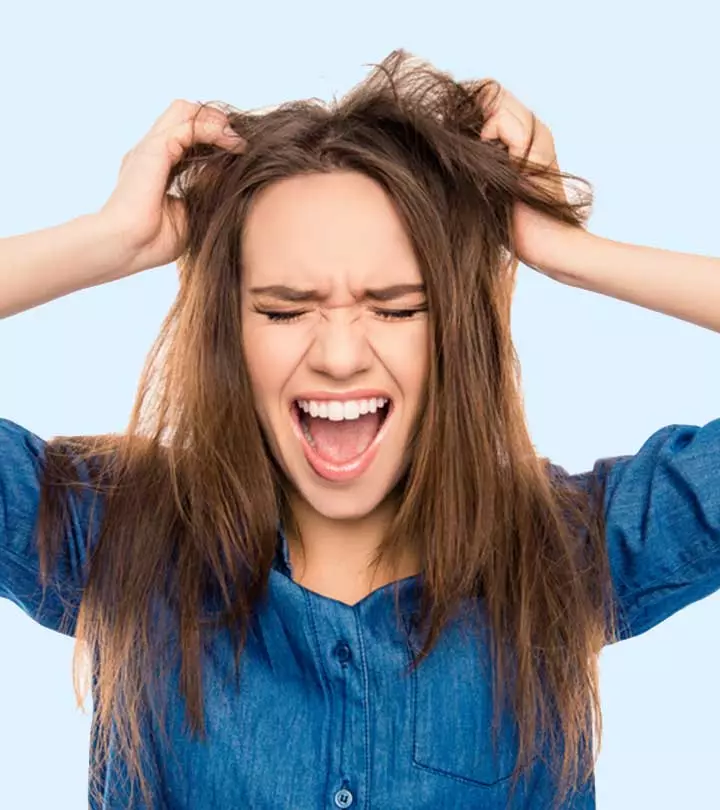
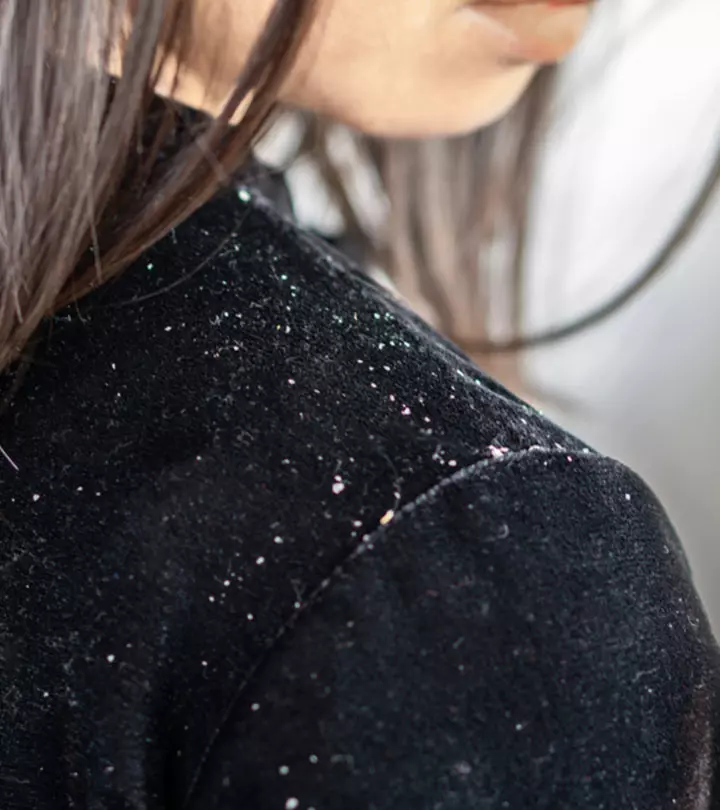
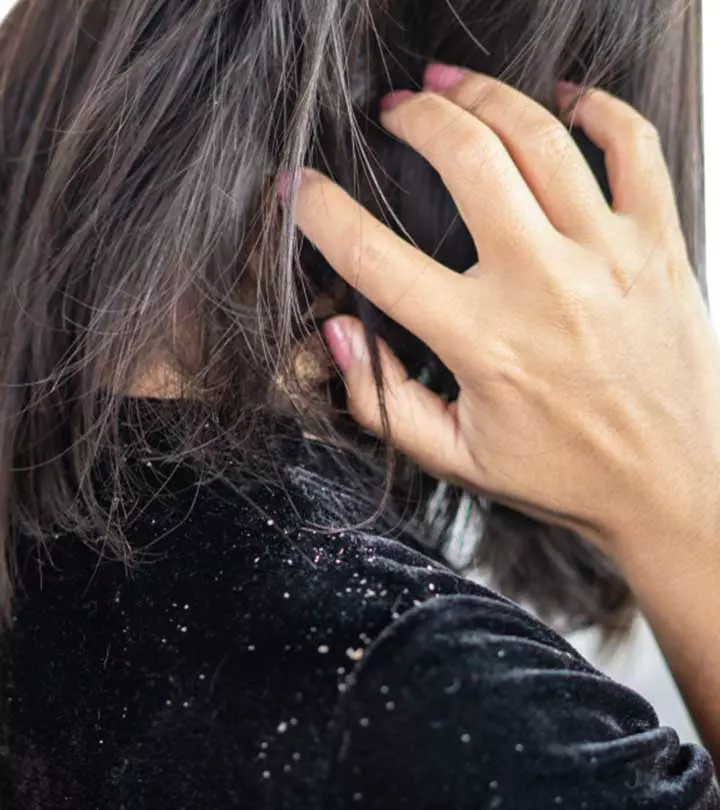
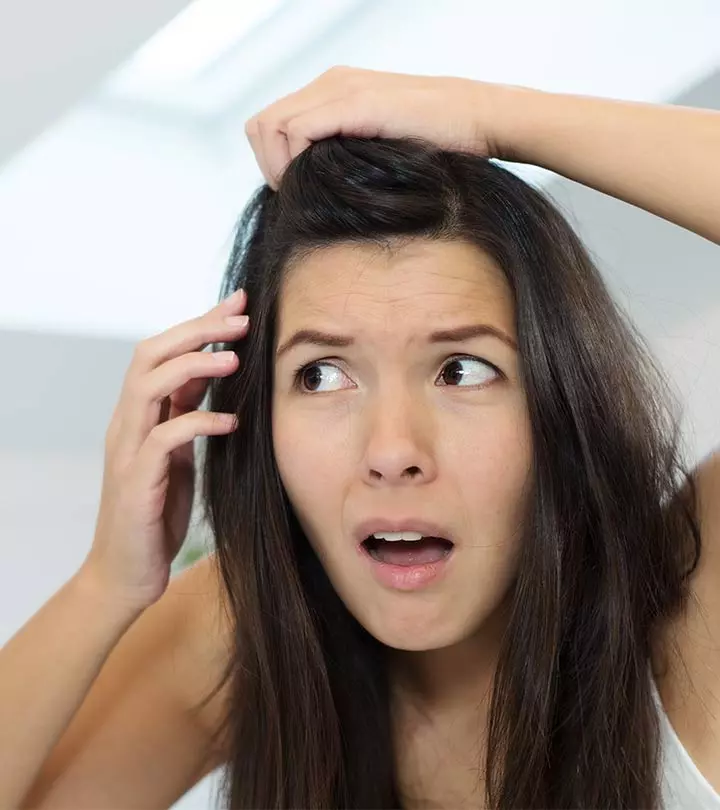
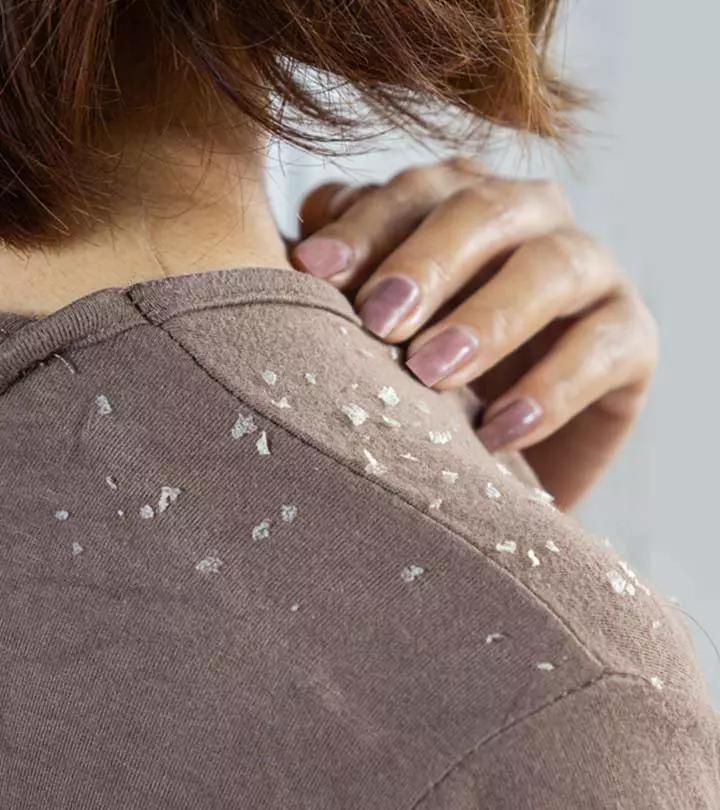
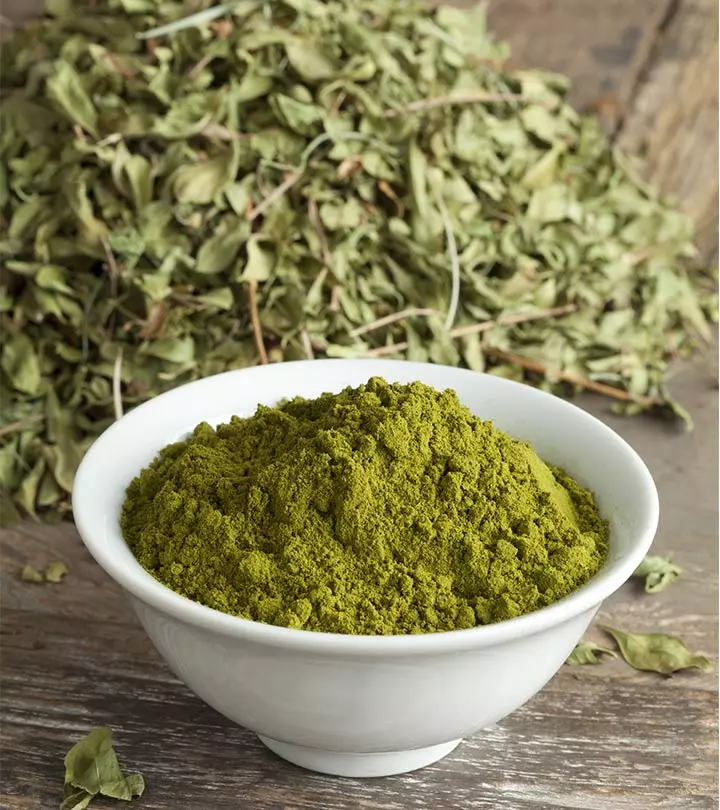
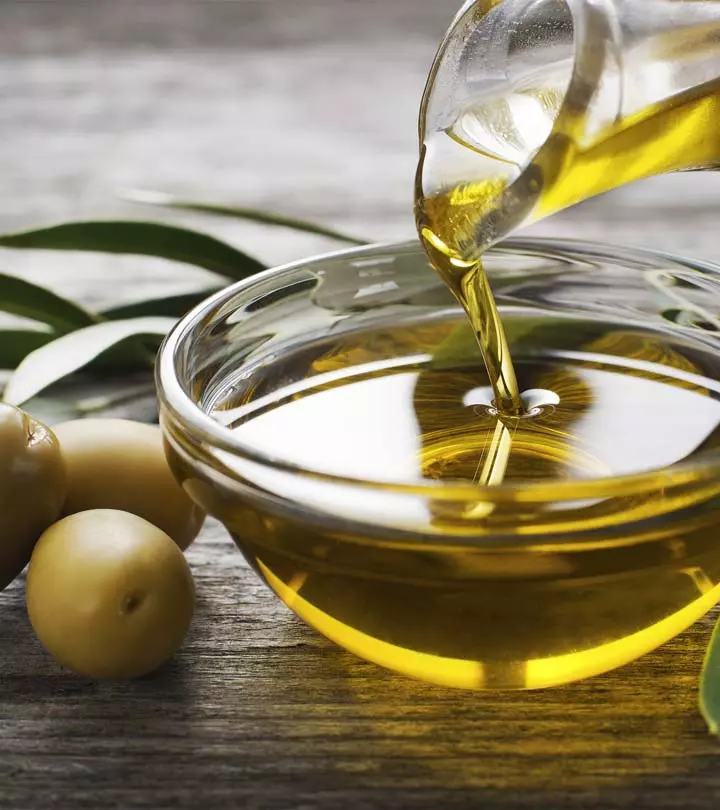

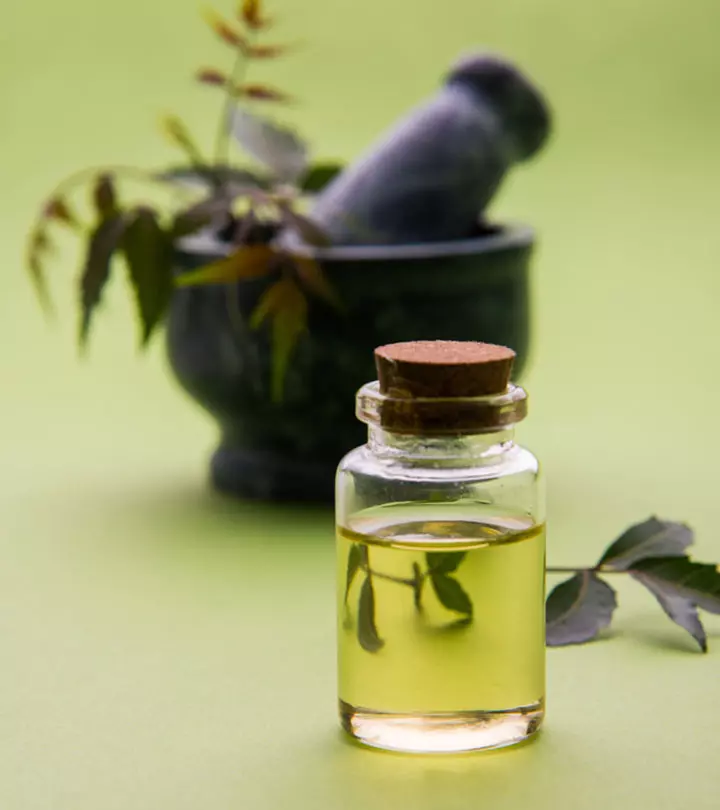
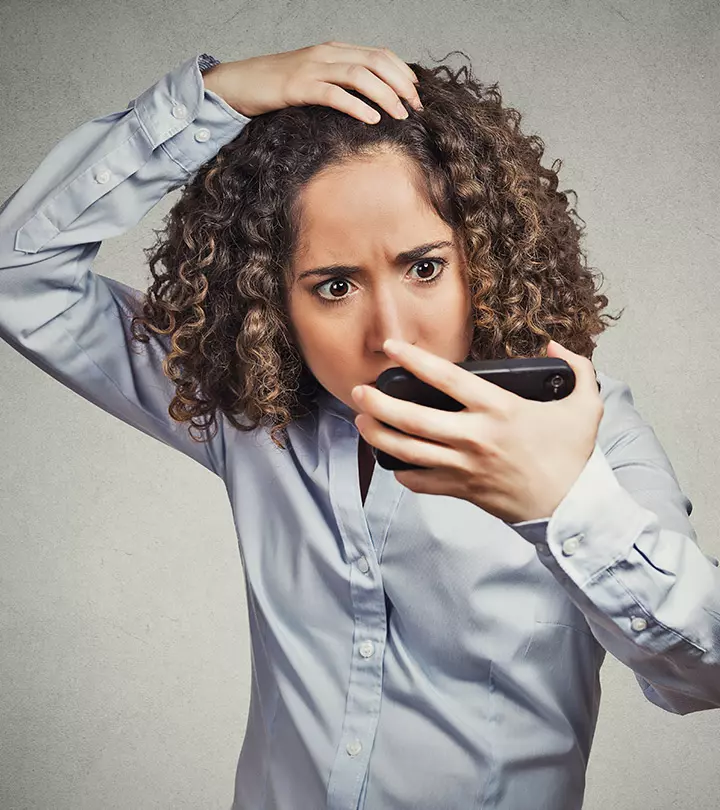
Community Experiences
Join the conversation and become a part of our empowering community! Share your stories, experiences, and insights to connect with other beauty, lifestyle, and health enthusiasts.